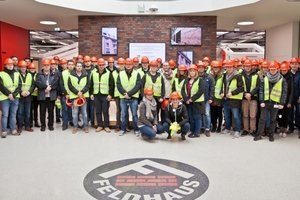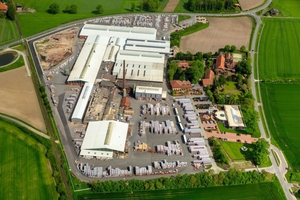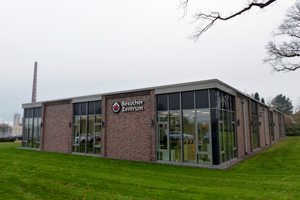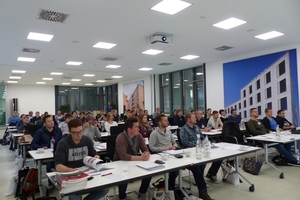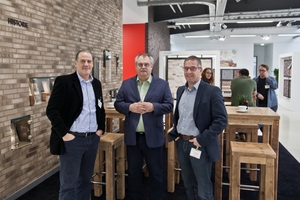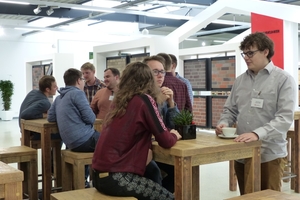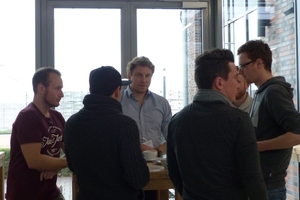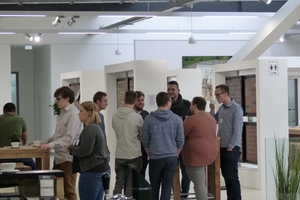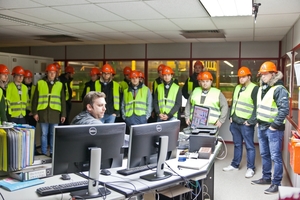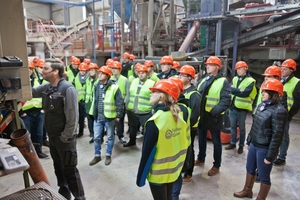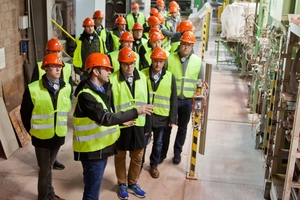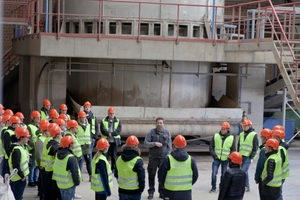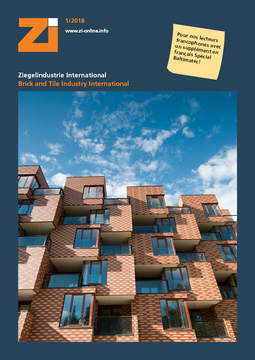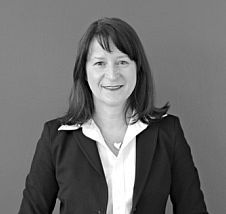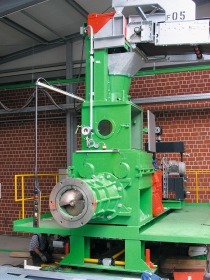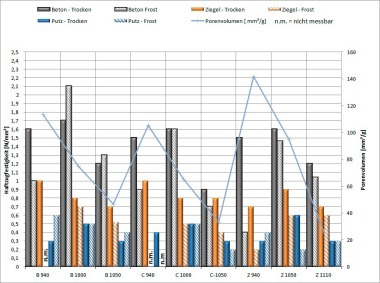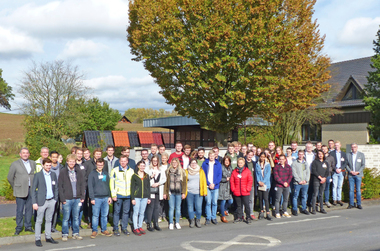Zi‘s 2017 student field trip with focus on facing brick and brick slip production
Responding to an invitation by Feldhaus Klinker in Bad Laer to come and get lots of professional information and career tips, more than 40 students, postgraduates and their tutors took part in the expert excursion organized by trade journal Zi Brick and Tile Industry International on 28 and 29 November 2017. The event was sponsored by seven industry partners.
Last year, we visited Feldhaus Klinker as the host of our student field trip, the intention being to generate enthusiasm for the brick and tile industry among future material technology/ceramics graduates.
And so, on 28 and 29 November, students and industry partners from the supplier and brick and tile sectors met in Bad Laer to learn about career opportunities in those areas under the direction of Prof. Dr.-Ing. Christian Schäffer from the Koblenz University of Applied Sciences, WesterWaldCampus, Department of Materials Engineering, Glass and Ceramics, Höhr-Grenzhausen, and Prof. Dr. rer. nat. Wolfgang Krcmar from Nuremberg Institute of Technology Georg Simon Ohm.
Following two roof tile plants and a backing-brick factory, the Feldhaus brick plant was the first producer of brick slips and facing bricks on our agenda. Feldhaus is known across the branch as an innovative, pioneering company. That fact, along with the good proffered prospects for young-talent recruitment, was certainly one of the reasons why we found it so easy to attract sponsors. Seven industry partners helped us to get the young people enthused about our industry. Some of them were with us for the fourth time this year:
Grothe Rohstoffe GmbH & Co. KG, Bückeburg
Hans Lingl Anlagenbau und Verfahrenstechnik GmbH & Co. KG, Krumbach
Keller HCW GmbH, Ibbenbüren
Petersen Service GmbH/Rehart GmbH, Netphen/Ehingen
Prince Minerals GmbH, Vallendar
Refratechnik Ceramics GmbH, Melle
VHV Anlagenbau GmbH, Hörstel
Thanks to these companies‘ commitment, higher-semester students were able to make contact with potential employers prior to graduation. For their part, the participating companies enjoyed the opportunity to get future graduates interested in what they have to offer. They provided the students with technical information via specialized lectures, an overview of the respective company and an outline of the available career opportunities.
Prof. Dr. Wolfgang Krcma and Prof. Dr.-Ing. Christian Schäffer escorted the groups of students and enriched the event with their technical expertise.
Feldhaus Klinker immediately gave us a positive response to our inquiry – the “junior specialists“ issue is a major concern for this producer of facing bricks and brick slips. Our thanks goes out to the Feldhaus executive team and to the lineup around Alexander Schröder, Florian Gersie and Maik Landwehr, all of whom supported us very enthusiastically and energetically. The generous conference facilities at Feldhaus‘ new visitor centre provided an ideal setting for the event.
Impressive variety of products and designs
In his welcoming address, Dirk Staasmeier, chief sales officer for Feldhaus products and for technical/design brick slip applications, emphasized the long tradition of this family enterprise, which celebrated its 160th founding anniversary in 2017. With a brand-new visitor centre, a virtual brick configurator and an ambitious investment plan, Feldhaus is fit for the future.
Making bricks is exciting!
Alexander Schröder, Chief Operating Officer for the production process and for commercial/technical career opportunities, explained the brick production process used by Feldhaus.
In business since 1857, Feldhaus is 100% family-owned and presently managed in its 4th and 5th generation by Bernhard Feldhaus and his daughter Nicola. Approximately 135 employees, including some 100 shop floor workers, produce roughly 100 000 t of fired wares per year: 2/3 facing bricks and 1/3 brick slips. The products are sold not only on the German market, but are also exported.
Red-burning slate clay and loam are extracted from the company‘s own three active mines in the near vicinity. Sand and a wide variety of extraneous clays are also employed. The plant has abundant storage capacity for the approximately 35 different raw materials, from which approx. 85 blends are produced. Dosed together via various box feeders, the compositions are processed in a pan mill, a primary roller mill and a finishing mill. Following extrusion, the green bricks are dried in a chamber dryer in preparation for firing at 900 to 1200° C, depending on the product. Conversely, the brick slips are loaded directly onto tunnel kiln cars. The angle slips, also directly extruded and placed without supporting bricks, constitute a special feature. This method accelerates angle-slip production by a factor of six – as compared to the traditional method (sawing them out of bricks). At present, the slips are still being packaged by hand, but an automatic unloader is scheduled for commissioning in 2018 as part of € 25 mill., five-year program geared to securing the location‘s future.
In the second part of his presentation, Alexander Schröder looked into Feldhaus‘ junior staff development efforts. Like many other companies, Feldhaus faces the challenge of finding suitable junior staff, and various paths are being pursued in that sense. Working with young people should begin at the pre-graduate level. In a typical joint project, the aim was to build the company a speed camera for use in monitoring traffic on the plant premises. Together with the Osnabrück University of Applied Sciences, a complaint processing project was conducted. For Schröder, it is important that no project be conducted “for the trash can“. He offered the students a chance to support bachelor or master theses. Indeed, there is great demand for creative young people who are able to think a project through and make suggestions on how it should look.
Asked why our branch of industry has no dual paths of study to offer, Prof. Schäffer responded that Höhr-Grenzhausen will be proffering a dual path of study in 2018. He emphasized how important it will be for the branch to show a positive response.
Continuous reduction in a tunnel kiln
After having lunch together, Rainer Hüsing from Keller HCW GmbH opened the programme of lectures with an overview of Keller‘s range of products and services and a rundown of potential tasks and fields of activity as a Keller ceramic engineer.
Then, he explained in his technical presentation how to control the fired colour by means of continuous reduction. Along with such firing conditions as the heating rate, retention time and prevailing temperature, the raw material properties and the atmosphere in the combustion chamber play an important role. Hüsing presented a Keller-built kiln in which continuous reduction is implemented by way of manipulated variables with control windows. The driving factor is the atmosphere, which must be kept uniform throughout the kiln.
Plant tour
During a detailed tour of the plant, the students were familiarized with its workings, from the elaborate storage of raw materials through their processing and shaping, and on to the handling, drying, firing and packaging steps. One group was led by Alexander Schröder and the other by Maik Landwehr. They both explained to the students all the various steps of brick and slip production. Of course, there was also ample opportunity to ask both specialists lots of questions.
From pit to roof
Simon Rennertz and Marcel Graf, Prince Minerals GmbH, told about their company, which was founded in 1858 and now belongs to a group of investors. Specialized in raw material refinement and value-added products, the company has been making annual acquisitions since 2003 and, in 2017, acquired the German company Opavsky – one of the Zi student excursion‘s good partners. A staff of 1300 produces for over 2000 customers in more than 65 countries. The product range for the brick and tile industry includes, for example, manganese additives and chrome ores, as well as frits, glazes and engobes. A case example was used to illustrate the development of a roof tile glaze. Here, the essential factors of influence are the firing temperature, the atmosphere, the TEC and, of course, the employed preparation and application techniques. The product development process encompasses laboratory testing, field trials, physical manufacture and quality assurance of the product.
Innovative modular material handling for the ceramic industry
In 1995, VHV Anlagenbau installed and commissioned a pair of belt conveyors for Feldhaus. As reported by Pia Ungruh, VHV Anlagenbau GmbH, both of them are still in operation.
In addition to conventional belt conveyors, VHV‘s team of 95 operatives also produces steep-incline conveyors, screening equipment and accessories. VHV is presently revamping and expanding its entire pilot plant and research facility, where customers can have their materials tested for such characteristics as suitability for steep-incline handling. Pia Ungruh very clearly explained the various systems and their respective modes of operation. Their modular construction is characterized by optimal planning, easy installation and maintenance, etc.
With regard to junior staff, VHV trains apprentices and is involved in the dual study program.
Get-together
One of the event‘s goals is to network participating companies and students with each other. The evening event was used very intensively for getting to know each other better and for making new contacts. Both the industry partners and the students made good use of the opportunity to exchange ideas about bachelor‘s and master‘s theses, launching a career and exploring available career opportunities.
Designing machines to fulfill given sets of specifications and application requirements
Max Pelczer, Rehart GmbH, and Thomas Kloft, Petersen Service GmbH, opened the second day of lectures with a presentation of the Rehart Group and its 230 employees at seven locations.
Taking Feldhaus as an example, Thomas Kloft investigated the issue of “Who develops machines?“. Feldhaus, as a pioneering brick slip producer, has dealt intensively with the question of how to extrude flat slips and corner slips. With that in mind, some temporary solutions for accordingly adapted machines have been developed in cooperation with the machine manufacturer. For example, the auger of the flat slip extruder was engineered for texture-free extrusion and uniform advance. Large maintenance openings and high vacuum tightness were also required.
Maximizing ROI on tunnel kiln cars
Joachim Dörr, Refratechnik Ceramics GmbH, informed the students about the globally active Refratechnik Group. In addition to refractory products for the ceramic industry, this family-operated company also makes products for the steel and cement sectors. Based in Melle, Refratechnik Ceramics is a system supplier of refractory superstructures for kiln roofs and walls, tunnel kiln cars and cassettes. All told, the company turns out some 70 000 t/hydraulically dry pressed products. This family enterprise is known for broad ranges of accountability and short decision-making channels.
Mario Hollmann, in his specialized lecture, described the use of TKC systems from two different angles: system durability (use of heavy products) vs. low energy consumption (lighter products). Either variant enables maximization of the ROI. For light products, it is essential to treat the TKCs with care in order to keep replacement material costs low. Conversely, heavy products should be used primarily in production settings characterized by robust conditions.
A subtle difference in the development of engobes and glazes for structural ceramic products
Jens-Uwe Flemming, Grothe Rohstoffe GmbH & Co. KG, acquainted the audience with this 3rd-generation family-operated enterprise, which develops, produces and distributes ceramic colours and pigments to customers around the globe. The product array includes engobes, redox colours and glazes, with the latter now accounting for the largest quantitative proportion. Feldhaus, by the way, is a Grothe customer of long standing.
Next, Michael Optenplatz explained the developmental peculiarities of roof tile glazes, from their physico-chemical properties to slip quality and firing technology. Taking the direct influence of alkaline-earth oxides on glaze development as an example, he called attention to the complexity of this developmental process. It is always important, he said, to accommodate the glazes to the brickmaker‘s own raw materials.
Energy-optimized brick and tile production – now and in the future
Laurenz Averbeck, Lingl GmbH & Co. KG, informed about this Krumbach-based middle-market company with approximately 500 employees. As a full-range supplier, Lingl serves customers all over the world in the areas of heavy clay, sanitaryware, industrial ceramics and refractories. Lingl offers a wide range of employment opportunities and is actively involved in the promotion of young talents. Averbeck stressed the fact that the heavy clay ceramics sector is facing a tremendous amount of change and that new developments need to be expedited. Major goals of relevance include the reduction of both energy expenditures and emissions. Lingl is currently working on a research project geared to enhancing energy efficiency through the use of internal hot cooling air for combustion. Energy savings as high as 30% are achievable. In 2018, Lingl plans to establish a wholly-owned subsidiary with focus on research and the bundling of expertise and know-how.
Final assessment
The 2017 field trip to Feldhaus Klinker‘s facing brick and brick slip factory once again inspired the attending students, for whom the excursion presented a very good opportunity to meet potential employers and to benefit from their experience.
The evaluation of questionnaires about the event showed that 84% of the students were satisfied or very satisfied with the choice of topics for their own professional careers, and that 86% of them were satisfied to very satisfied with the technical quality of the presentations. As always, the factory tour gave the young people direct insight into the production and brick manufacturing processes as a highlight of the event.
In addition to their quest for knowledge, the students are always interested in obtaining information on training, entry options and career opportunities in the various companies. This gives our industry partners a good chance to appear as attractive employers and to establish initial contacts. And, even a company needs no new employees just now, the participating students might come around again sometime in the future – as customers!
Both professors pointed out how important it is for the students to obtain early insight into the technology of the brick and tile industry and its suppliers. The Zi student field trip, they said, is a very good opportunity to get to know each other and exchange information.
Our thanks goes to our hosts, the Feldhaus Klinker team and the Feldhaus family, for such great support. Thanks also to our industry partners, whose contributions made this event possible. Together, we were able to give future managers a taste of the brick and tile industry and its suppliers and a chance to establish some initial contacts.
Outlook
This year, too, with the help of our industry partners, we will be staging another field trip to a brick plant. As some brick people may already have noted, the search for well-qualified junior staff is becoming increasingly difficult. Also, a number of plants will be needing successors sometime within the near future. So, take this opportunity to present yourself as an attractive employer to interested students. If you happen to be interested in having your brick factory host our next student excursion or in supporting the event as an industry partner, please give me a call at + 49 5241 80-89264 for registration!
www.zi-online.info

